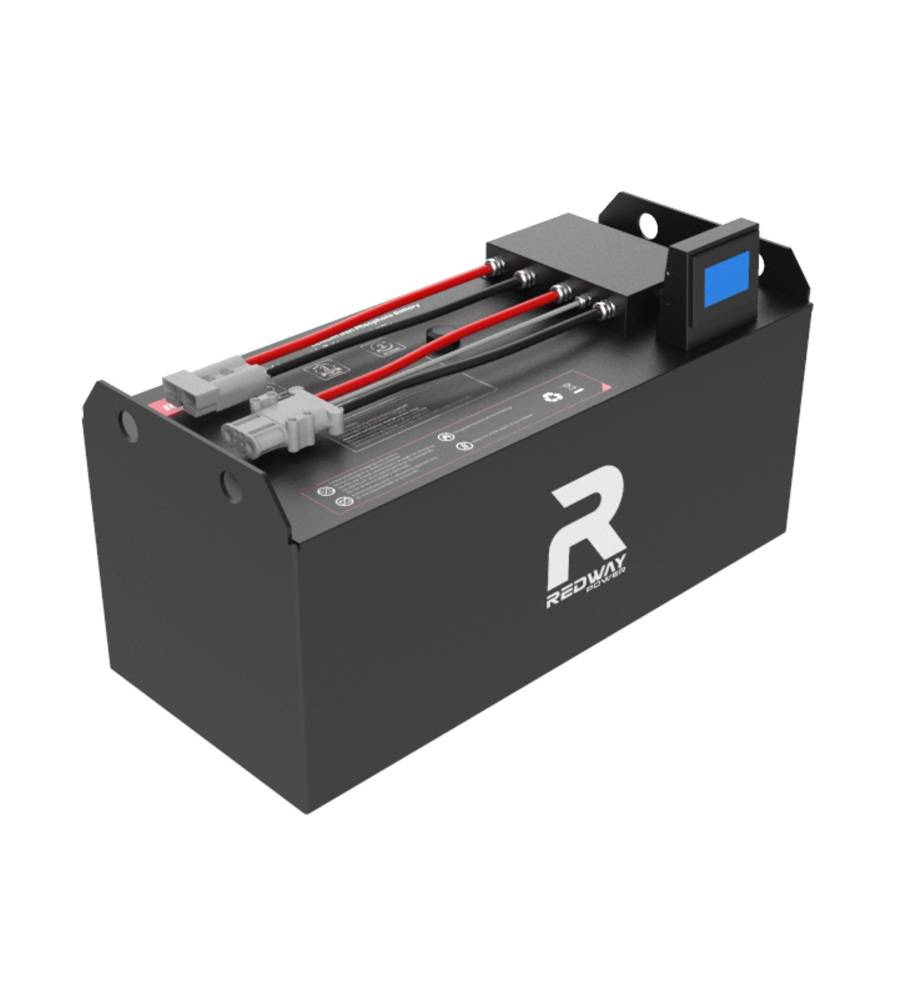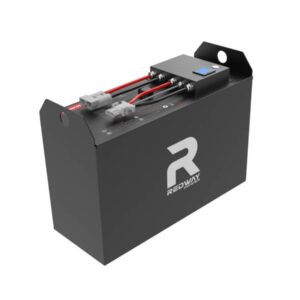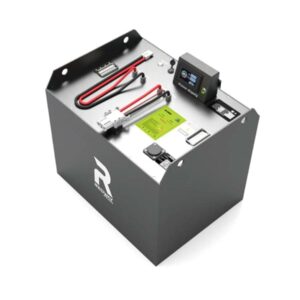Description
Overview
Our 48V 460Ah LiFePO4 Forklift Battery is engineered for high-performance industrial applications. As a leading lithium battery manufacturer, we deliver OEM-ready solutions with 21.5kWh nominal energy, advanced safety features, and cloud-based monitoring. Built for durability and efficiency, it¡¯s ideal for heavy-duty equipment and renewable energy storage.
Key Features
High Capacity & Longevity
With 420Ah capacity and a lifespan exceeding 3,500 cycles at 80% DOD, this lithium battery ensures reliable power for years. Its LiFePO4 chemistry guarantees thermal stability and extended service life, reducing replacement costs.
Robust Performance
Supports 300A continuous discharge and 1,000A peak surge (5s), making it suitable for high-demand machinery. The natural cooling system and IP67-rated metal shell ensure optimal operation in harsh environments.
Smart Monitoring
Integrated 4G cloud monitoring and an on-device LCD screen provide real-time insights into SOC, voltage, and temperature. Advanced BMS protects against overcurrent, overheating, and short circuits.
Product Description
Designed for OEM integration, this lithium battery combines 51.2V nominal voltage with compact dimensions (950x421x450 mm) for space-efficient installations. The 16S2P cell configuration enhances energy density, while RS485/CAN-bus communication ensures seamless compatibility with industrial systems.
Flexible Charging
Equipped with a Rema 320A charging connector and Anderson 350A discharge port, it supports rapid energy transfer. The wide operating range (40V¨C58.4V) accommodates fluctuating power inputs, ideal for hybrid setups.
Technical Excellence
Optimized for Industry
With a -20¡ãC to 60¡ãC discharge range, this battery thrives in extreme conditions. Its metal casing resists corrosion, and the lightweight design (~190 kg) simplifies handling without compromising structural integrity.
Warranty and Support
Backed by a 5-year/3,500-cycle warranty, our lithium battery solutions prioritize customer confidence. As a trusted OEM partner, we offer customization and technical support to align with your specific application needs.
Applications
Ideal for forklifts, AGVs, telecom infrastructure, and solar storage systems. The 48V 460Ah LiFePO4 Forklift Battery delivers unmatched efficiency for businesses seeking scalable, sustainable energy solutions.
48V 420Ah LiFePO4 Forklift Batteries Specifications & Performance
What are the key specifications of 48V 420Ah LiFePO4 forklift batteries?
The 48V 420Ah LiFePO4 forklift batteries are designed to provide high energy capacity for industrial applications. With a nominal voltage of 48V, they offer a capacity of 420Ah, supporting long operational cycles before requiring a recharge. These batteries are lightweight and have excellent thermal stability, making them ideal for heavy-duty forklifts. They feature advanced battery management systems (BMS) to ensure safety and optimize battery life, ensuring long-lasting performance in challenging environments.
Why choose LiFePO4 chemistry for high-capacity industrial batteries?
LiFePO4 chemistry is an excellent choice for high-capacity industrial batteries due to its long lifespan, safety, and high energy density. It offers faster charging times and is more stable under varying temperatures compared to other lithium-ion chemistries. Additionally, LiFePO4 batteries have minimal maintenance requirements, reducing downtime and service costs. Their eco-friendly nature and resistance to thermal runaway make them the preferred choice for high-demand industries like warehousing and manufacturing.
What industries commonly use 48V 420Ah LiFePO4 forklift batteries?
Industries that rely on high-performance material handling equipment frequently use 48V 420Ah LiFePO4 forklift batteries. These include warehousing, logistics, manufacturing, and distribution centers. The battery’s high capacity allows it to efficiently power electric forklifts, reach trucks, and other industrial equipment for extended shifts, offering superior reliability and minimal downtime. Additionally, industries focusing on sustainability and reducing their carbon footprint prefer LiFePO4 batteries for their eco-friendly attributes.
How does temperature affect 48V 420Ah LiFePO4 battery performance?
Temperature significantly impacts the performance of 48V 420Ah LiFePO4 batteries. High temperatures can cause the battery to degrade faster, reducing its lifespan and charging efficiency. Conversely, cold temperatures can temporarily reduce battery performance by slowing down chemical reactions. It’s essential to operate LiFePO4 batteries within the recommended temperature range (typically 0°C to 45°C) to ensure optimal performance and longevity. Managing temperature conditions through climate control or proper storage helps maximize the battery’s lifespan.
What safety features do LiFePO4 forklift batteries typically include?
LiFePO4 forklift batteries come equipped with several safety features to protect against overcharging, overheating, and short circuits. These include a Battery Management System (BMS) that monitors the state of charge, temperature, and voltage. The system helps to prevent thermal runaway, a common issue with other battery chemistries. Additionally, LiFePO4 batteries have built-in current protection, fuse systems, and thermal sensors, ensuring safe operation even under demanding conditions.
How to maintain 48V 420Ah LiFePO4 batteries for optimal lifespan?
To maintain 48V 420Ah LiFePO4 batteries for optimal lifespan, it’s essential to avoid deep discharges and charge the battery before it reaches critical low levels. Use the correct charger and ensure the battery operates within its recommended temperature range. Regularly check the Battery Management System (BMS) to monitor voltage, temperature, and current. Store the batteries in a cool, dry place when not in use, and keep terminals clean to prevent corrosion.
LiFePO4 vs Lead-Acid Batteries: Cost, Lifespan, and Maintenance
What are LiFePO4 battery advantages for forklifts?
LiFePO4 batteries offer several advantages for forklifts, including longer lifespan, faster charging, and higher energy density compared to lead-acid batteries. They require minimal maintenance and do not need watering, reducing service costs. Their safety is superior, with less risk of thermal runaway or acid leakage. LiFePO4 batteries also provide consistent performance throughout their charge cycle, improving productivity and reducing downtime, making them a cost-effective solution in the long term.
How to choose reliable LiFePO4 battery suppliers?
When choosing reliable LiFePO4 battery suppliers, prioritize companies that offer certifications, a solid warranty, and have a strong track record in the forklift industry. Look for suppliers who offer customer support, battery customization, and have transparent quality control processes. Supplier reputation, performance guarantees, and their ability to provide ongoing service are essential factors in ensuring a dependable supply of batteries. Always compare reviews and ratings to gauge reliability.
LiFePO4 vs lead-acid: cost comparison for forklifts?
While the initial cost of LiFePO4 batteries is typically higher than lead-acid, they provide long-term cost savings. LiFePO4 batteries last up to 4-6 times longer than lead-acid batteries, reducing the need for frequent replacements. They also charge faster, leading to less downtime. Over time, lower maintenance costs, no need for watering, and fewer replacements make LiFePO4 batteries more cost-effective compared to lead-acid batteries, which have a higher total cost of ownership.
Top certifications for forklift LiFePO4 suppliers?
Top certifications for forklift LiFePO4 suppliers include ISO 9001, which ensures high-quality manufacturing standards, and CE certification, confirming compliance with European safety regulations. Many suppliers also offer UL certification for safety standards in North America. RoHS compliance (Restriction of Hazardous Substances) ensures the absence of harmful materials in the battery. These certifications assure customers of safety, quality, and environmental compliance in the products they purchase.
Maintenance tips for LiFePO4 forklift batteries?
To maximize the life of LiFePO4 forklift batteries, regularly monitor the State of Charge (SOC) and avoid discharging them below 20%. Use the proper charging equipment to avoid overcharging. Store batteries in a cool, dry location to prevent temperature-related degradation. Keep battery terminals clean and free of corrosion, and check the Battery Management System (BMS) regularly for proper functioning. Following these practices ensures optimal performance and longevity.
Best LiFePO4 suppliers in China for forklifts?
Some of the best LiFePO4 suppliers in China for forklifts include BYD, CATL, and Pylontech. These suppliers are known for their reliable, high-quality products, extensive experience in the electric vehicle industry, and robust supply chains. They offer a wide range of customizable battery solutions, competitive pricing, and meet international safety standards, making them ideal choices for industrial forklift applications worldwide.
LiFePO4 vs Lead-Acid: Key Performance Metrics
What are cost differences between LiFePO4 and lead-acid?
LiFePO4 batteries have a higher upfront cost compared to lead-acid batteries, but they offer long-term savings due to their longer lifespan, lower maintenance costs, and faster charging times. The initial cost of LiFePO4 can be up to 2-3 times higher, but the overall total cost of ownership is lower due to fewer replacements and operational cost savings over time.
How do LiFePO4 and lead acid batteries compare in lifespan?
LiFePO4 batteries have a significantly longer lifespan than lead-acid batteries. A LiFePO4 battery typically lasts 4,000 to 6,000 charge cycles, whereas lead-acid batteries last around 1,000 to 1,500 cycles. This means LiFePO4 batteries can last up to 5 times longer, offering greater value for money over the long term and reducing the need for frequent replacements.
Which battery type offers better energy density for forklifts?
LiFePO4 batteries provide better energy density than lead-acid batteries. This means that for the same weight or volume, LiFePO4 batteries can store more energy, leading to longer operational times between charges. With higher energy density, LiFePO4 batteries are more compact and lighter, making them ideal for applications where space and weight constraints are important.
Do LiFePO4 batteries require less maintenance than lead acid?
Yes, LiFePO4 batteries require significantly less maintenance than lead-acid batteries. Unlike lead-acid batteries, LiFePO4 batteries do not need to be topped up with water or have acid levels checked. They also do not suffer from sulfation, which is common in lead-acid batteries. LiFePO4 batteries are sealed and maintenance-free, requiring only periodic checks of the Battery Management System (BMS).
Are LiFePO4 batteries safer in high-temperature environments?
LiFePO4 batteries are safer in high-temperature environments compared to lead-acid batteries. Their thermal stability reduces the risk of thermal runaway, a common problem with lead-acid batteries under extreme conditions. LiFePO4 batteries can handle higher temperatures without significant degradation in performance, making them suitable for demanding industrial environments where temperatures may fluctuate.
What environmental impacts differentiate LiFePO4 from lead acid?
LiFePO4 batteries have a much lower environmental impact compared to lead-acid batteries. They are non-toxic and non-hazardous, with no lead or sulfuric acid to worry about during disposal. Additionally, LiFePO4 is made from abundant raw materials, reducing the environmental footprint. Lead-acid batteries, on the other hand, contain lead and acid, which are harmful to the environment and require careful recycling.
Charging, Maintenance & Storage of LiFePO4 Forklift Batteries
**How to safely charge a 420Ah LiFePO4 battery
?**
To safely charge a 420Ah LiFePO4 battery, always use the recommended charger designed for LiFePO4 chemistry. Ensure the charger is set to the correct voltage and current settings for the battery’s specifications. Avoid overcharging by stopping the charge once the battery reaches its maximum charge voltage (typically 3.65V per cell). Charging should take place in a cool, dry environment to prevent overheating. Regularly inspect the Battery Management System (BMS) for safety.
What storage conditions optimize LiFePO4 battery lifespan?
To optimize the lifespan of LiFePO4 batteries, store them in a cool (around 20-25°C) and dry environment. Avoid storing them in direct sunlight or areas that experience extreme temperature fluctuations. Charge the battery to 50-70% capacity if storing for extended periods, and avoid letting the battery discharge completely. Ensure the terminals are clean and free of corrosion before storage, and periodically check the battery’s state of charge during long-term storage.
How does temperature affect LiFePO4 battery performance?
Temperature significantly influences LiFePO4 battery performance. At low temperatures, the chemical reactions inside the battery slow down, reducing efficiency and capacity. At high temperatures, the battery can overheat, potentially leading to faster degradation. It’s crucial to keep the battery within an optimal temperature range (typically 0-45°C) for best performance. Batteries operating outside this range may experience reduced cycle life and charging inefficiency.
Why is cell balancing crucial for LiFePO4 maintenance?
Cell balancing ensures that all individual cells within a LiFePO4 battery are charged equally, preventing any cells from being overcharged or undercharged, which can shorten the battery lifespan. The Battery Management System (BMS) typically handles this process automatically, but regular checks ensure that cells maintain uniform voltage levels. Proper cell balancing improves the overall efficiency and performance of the battery, ensuring its longevity and preventing premature failures.
How to identify LiFePO4 battery degradation signs?
Signs of LiFePO4 battery degradation include reduced capacity, increased charging time, and frequent voltage drops during usage. The battery may also show uneven performance or reduced runtime per charge. If the Battery Management System (BMS) indicates abnormal voltage levels across cells or if the battery experiences overheating, these may be signs that the battery is nearing the end of its lifecycle and may require replacement.
Recommended cleaning methods for LiFePO4 battery terminals?
To clean LiFePO4 battery terminals, use a dry cloth or soft brush to gently remove dust or debris. If there’s corrosion, use a baking soda solution (mix one tablespoon of baking soda with water) to neutralize the acid. After cleaning, wipe the terminals with a dry cloth and ensure the connections are tight. Always wear protective gloves and safety glasses during cleaning to avoid contact with any potential residue.







